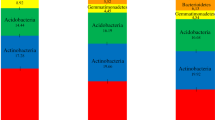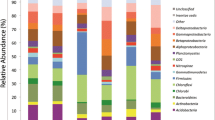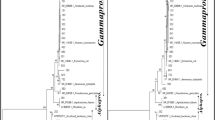Abstract
The long-term effects of methylparathion contamination on the diversity of soil microbial community was investigated by a culture-independent approach using small subunit ribosomal RNA (SSU rRNA) gene-based cloning. Microbial DNA extracted from both the control soil sample and methylparathion contaminated soil sample was subjected to PCR amplification with primers specific for bacterial 16S rRNA gene sequences. From the PCR amplification product, clone libraries were constructed for both samples. Phylotypes were defined by performing a restriction fragment length polymorphism analysis of 16S rRNA gene sequences with the enzymes RsaI and HhaI. A total of 603 phylotypes were identified among the 16S ribosomal DNA (rDNA) clones, the phylotype richness, frequency distribution (evenness) of the two clone libraries were compared by using a variety of diversity indices. Phylogenetic analysis of the sequences of the dominant phylotypes revealed that the bacterial communities changed noticeably. In the control soil, the dominant bacterial groups included a member of a novel bacterial division, the bacillus genus, and a member of α-proteobacteria, while in methylparathion contaminated soil, the dominant phylotypes were replaced by a member of the flexibactera-cytophaga-bacteroides division and two members of the γ-proteobacteria subdivision. This is the first report of the long-term effects of methylparathion (one of the major pesticides widely used in developing countries) on soil microbial community diversity and structure by a culture-independent method, and provides the evidences to assess the long-term environmental toxicological effects of methylparathion from the microbial community viewpoint.


Similar content being viewed by others
References
Amann RI, Ludwig W, Schleifer KH (1995) Phylogenetic identification and in situ detection of individual microbial cells without cultivation. Microbiol Rev 59:143–169
Cheryl RK, Susan MB, Joseph DB (1997) Diverse uncultivated bacterial groups from soils of the arid southwestern united states that are present in many geographic regions. Appl Environ Microbiol 63:3614–3621
Clark JM, Bing-Canar J, Renninger S, Dollhopf R, El-Zein J, Star D, Zimmerman D, Anisuzzaman A, Boylan K, Tomaszewski T, Pearce K, Yacovac R, Erlwein B, Ward J (2002) Methyl parathion in residential properties: relocation and decontamination methodology. Environ Health Perspect 6(Suppl):1061–1070
Cole JR, Chai B, Marsh TL, Farris RJ, Wang Q, Kulam SA, Chandra S, McGarrell DM, Schmidt TM, Garrity GM, Tiedje JM (2003) The Ribosomal Database Project (RDP-II): previewing a new autoaligner that allows regular updates and the new prokaryotic taxonomy. Nucleic Acids Res 31:442–443
Edwards U, Rogall T, Blocker H, Emde M, Bottger EC (1989) Isolation and direct complete determination of entire genes. Nucleic Acids Res 17:7843–7853
Ellis RJ, Morgan P, Weightman AJ, Fry JC (2003) Cultivation-dependent and -independent approaches for determining bacterial diversity in heavy-metal-contaminated soil. Appl Environ Microbiol 69:3223–3230
Kolosova AY, Park JH, Eremin SA, Kang SJ, Chung DH (2003) Fluorescence polarization immunoassay based on a monoclonal antibody for the detection of the organophosphorus pesticide parathion-methyl. J Agric Food Chem 51:1107–1114
Kopczynski ED, Bateson MM, Ward DM (1994) Recognition of chimeric small-subunit ribosomal DNAs composed of genes from uncultivated microorganisms. Appl Environ Microbiol 60:746–748
López L, Pozo C, Rodelas B, Calvo C, Juárez B, Martínez-Toledo MV, González-López J (2005) Identification of bacteria isolated from an oligotrophic lake with pesticide removal capacities. Ecotoxicology 14:299–312
Luchini LC, Peres TB, de Andrea MM (2000) Monitoring of pesticide residues in a cotton crop soil. J Environ Sci Health 35:51–59
Ludwig W, Bauer SH, Bauer M, Held I, Kirchhof G, Schulze R, Huber I, Spring S, Hartmann A, Schleifer KH (1997) Detection and in situ identification of representatives of a widely distributed new bacterial phylum. FEMS Microbiol Lett 153:181–190
Luo YC, Zeng QR, Wu G, Luan ZK, Liao BH (2003) Effect of beta-cyclodextrin compounds on the solubilization of three selected pesticides and their toxicity with methyl-parathion to Rana tigrina tadpoles. Bull Environ Contam Toxicol 70:998–1005
Macrae A, Rimmer DL, O’Donnell AG (2000) Novel bacterial diversity recovered from the rhizosphere of oilseed rape (Brassica napus) determined by the analysis of 16S ribosomal DNA. Antonie Van Leeuwenhoek 78:13–21
Moyer CL, Tiedje JM, Dobbs FC, Karl DM (1996) A computer-simulated restriction fragment length polymorphism analysis of bacterial small-subunit rRNA genes: efficacy of selected tetrameric restriction enzymes for studies of microbial diversity in nature. Appl Environ Microbiol 62:2501–2507
Qui X, Wu L, Huang H, McDonel PE, Palumbo AV, Tiedje JM, Zhou J (2001) Evaluation of PCR-generated chimeras, mutations, and heteroduplexes with 16S rRNA gene-based cloning. Appl Environ Microbiol 67:880–887
Sambrook J, Fritsch EF, Maniatis T (1989) Molecular cloning: a laboratory manual, 2nd edn. Cold Spring Harbor Laboratory Press, Cold Spring Harbor, NY
Somerville L, Greaves MP (1987) Pesticide effects on soil microflora. Taylor and Francis, New York, NY
Thompson JD, Gibson TJ, Plewniak F, Jeanmougin F, Higgins DG (1997) The ClustalX windows interface: flexible strategies for multiple sequence alignment aided by quality analysis tools. Nucleic Acids Res 24:4876–4882
Tsakiris IN, Toutoudaki M, Nikitovic DP, Danis TG, Stratis IA, Tsatsakis AM (2002) Field study for degradation of methyl parathion in apples cultivated with integrated crop management system. Bull Environ Contam Toxicol 69:771–778
Wagner ED, Marengo MS, Plewa MJ (2003) Modulation of the mutagenicity of heterocyclic amines by organophosphate insecticides and their metabolites. Mutat Res 36:103–115
Wang GC-Y, Wang Y (1996) The frequency of chimeric molecules as a consequence of PCR co-amplification of 16S rRNA genes from different bacterial species. Microbiology 142:1107–1114
Wang GC-Y, Wang Y (1997) Frequency of formation of chimeric molecules as a consequence of PCR coamplification of 16S rRNA genes from mixed bacterial genomes. Appl Environ Microbiol 63:4645–4650
Ward DM, Weller R, Bateson MM (1990) 16S rRNA sequences reveal numerous uncultured microorganisms in a natural community. Nature 344:63–65
Wardle DA, Parkinson D (1990) Effects of three herbicides on soil microbial biomass and activity. Plant Soil 122:21–28
Wilson KH, Blitchington RB, Green RC (1990) Amplification of bacterial 16S ribosomal DNA with polymerase chain reaction. J Clin Microbiol 28:1942–1946
Zhang RF, Cui ZL, Jiang JD, He J, Gu XY, Li SP (2005) Diversity of organophosphorus pesticide-degrading bacteria in a polluted soil and conservation of their organophosphorus hydrase genes. Can J Microbiol 51:337–343
Zhou JZ, Bruns MA, Tiedje JM (1996) DNA recovery from soils of diverse composition. Appl Environ Microbiol 62:316–322
Zhou JZ, Xia BC, Huang HS, David ST, Loren JH, Richard JM, Anthony VP, Tiedje JM (2003) Bacterial phylogenetic diversity and a novel candidate division of two humid region, sandy surface soils. Soil Biol Biochem 35:915–924
Acknowledgements
This work was supported by grants 30400014 from the Chinese National Natural Science Foundation, and by the Chinese National Programs for High Technology Research and Development (2003AA241150).
Author information
Authors and Affiliations
Corresponding author
Rights and permissions
About this article
Cite this article
Zhang, R., Jiang, J., Gu, JD. et al. Long term effect of methylparathion contamination on soil microbial community diversity estimated by 16S rRNA gene cloning. Ecotoxicology 15, 523–530 (2006). https://doi.org/10.1007/s10646-006-0088-y
Accepted:
Published:
Issue Date:
DOI: https://doi.org/10.1007/s10646-006-0088-y




